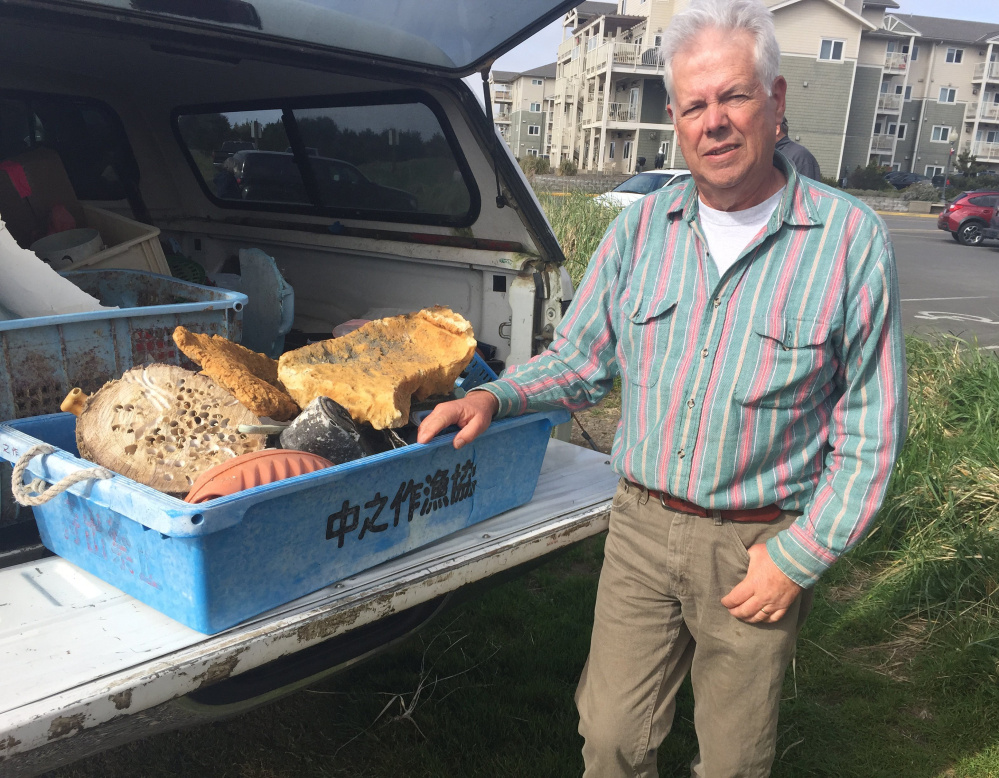LONG BEACH, Wash. — Several times each week, Russ Lewis and a few friends pick up litter that washes ashore on a 7-mile stretch of ocean shoreline, and most of it is plastics of one kind of another.
Some of the stuff, such as the strapping akin to what Northwest crabbers use to wrap around bait, most likely comes from close by.
Other items, such as a mannequin head with Japanese writing, are presumed to be part of the detritus from the March 2011 Japanese tsunami that continues to wash ashore in the Pacific Northwest.
“Sometimes the truck looks like a covered wagon, it is so loaded down with trash,” said Lewis, a retired federal worker who lives in Ocean Park.
Plastics are one of the most ubiquitous products of the petrochemical industry. One study estimates the oceans receive nearly 6 million to almost 13 million metric tons of plastics each year. This debris takes a huge toll on birds, fish, marine mammals and other sea life, either through entanglement or ingestion of degraded bits and pieces.
“It really is a systemic threat to the health of the ocean itself,” said Kathryn Sullivan, administrator of the National Oceanic and Atmospheric Administration, who visited Long Beach last week to help mark the 10th anniversary of an agency program that works to combat marine debris.
‘A SLOW POISONING’
“If we open the stomachs of dead and stranded mammals and seabirds, we are finding increasing amounts of marine debris – plastics, Styrofoam, beads and such – in their guts. That’s like a slow poisoning from within,” Sullivan said.
Plastics dominate the human-generated trash strewn along Washington’s coasts. One two-year survey of 17 coastal sites found that plastics formed 92 percent of marine debris, according to Liam Antrim, a researcher at the Olympic Coast National Marine Sanctuary, who presented his findings last week in Long Beach.
Some of this debris comes from regional sources, such as trash washed out to sea by the Columbia or other rivers, or gear lost from coastal fishing boats or oyster farms.
Other debris spins off from a massive collection point – a gyre – that circles about in the North Pacific. Though it is sometimes called the garbage patch, NOAA researchers say this gathering zone is largely made up of smaller pieces of plastic, which may lie below the surface and are not easily seen from the side of a boat.
TSUNAMI DEBRIS
Some of this material consists of microplastics – beads, fibers and pellets used in manufacturing or degraded from larger chunks. These have been found in the stomachs of marine life ranging from plankton to whales, and NOAA reports that researchers are studying how they may move through the food chain.
Marine debris from the Japanese tsunami also gets caught in the gyre, and some of that material continues – a half-decade later – to make its way to Washington’s coasts.
Lewis, a beachcomber who in 2012 decided to focus on beach cleanups, has been monitoring the flow of suspected tsunami debris, such as chunks of foam housing insulation and plastic bottles, and totes with Japanese writing.
Lewis and his team annually haul away about 10 tons of debris from the beaches, and he estimates that about half is suspected Japanese debris.
He said most of what arrives now is slower-moving debris below the water line and thus – unlike high-riding buoys – didn’t get a boost from prevailing winds.
The tsunami debris also has proved to be a surprisingly capable transporter of coastal species from one continent to another. More than 350 Japanese species have been identified on objects that washed ashore in Hawaii or on the North American Pacific Coast. About 100 of those species were found in Washington.
They include fish, mollusks, algae and many other forms of sea life, according to Allen Pleus, who leads an aquatic invasive species program for the state Department of Fish and Wildlife.
Some of these Japanese species arrived on two concrete docks swept away from the port of Misawa.
Others species were found attached to – or in – Japanese boats, largely made from fiberglass, that came ashore.
So far, 65 of these boat and boat pieces have been found on the coastlines of Hawaii and North America.
Twenty-five of those came ashore in Washington, including a 16-foot fiberglass skiff found just last month south of Kalaloch Beach, with registration numbers now being checked by the Japanese consulate.
The number of Japanese species found on this debris varies greatly.
“It is very strange,” Pleus said. “Sometimes it comes in, and you find only a handful. And sometimes it comes in and looks like Noah’s Ark.”
Some experts worry that newly introduced species could establish themselves in the Northwest and eventually harm native Northwest species.
“We don’t know, and we’re not looking very closely,” Pleus said. “The resources that we have now are very limited.”
Send questions/comments to the editors.



Success. Please wait for the page to reload. If the page does not reload within 5 seconds, please refresh the page.
Enter your email and password to access comments.
Hi, to comment on stories you must . This profile is in addition to your subscription and website login.
Already have a commenting profile? .
Invalid username/password.
Please check your email to confirm and complete your registration.
Only subscribers are eligible to post comments. Please subscribe or login first for digital access. Here’s why.
Use the form below to reset your password. When you've submitted your account email, we will send an email with a reset code.